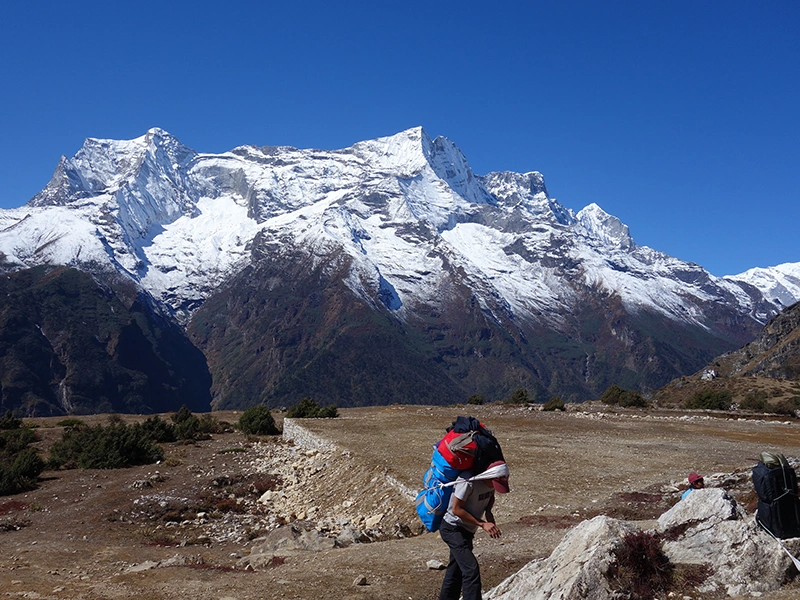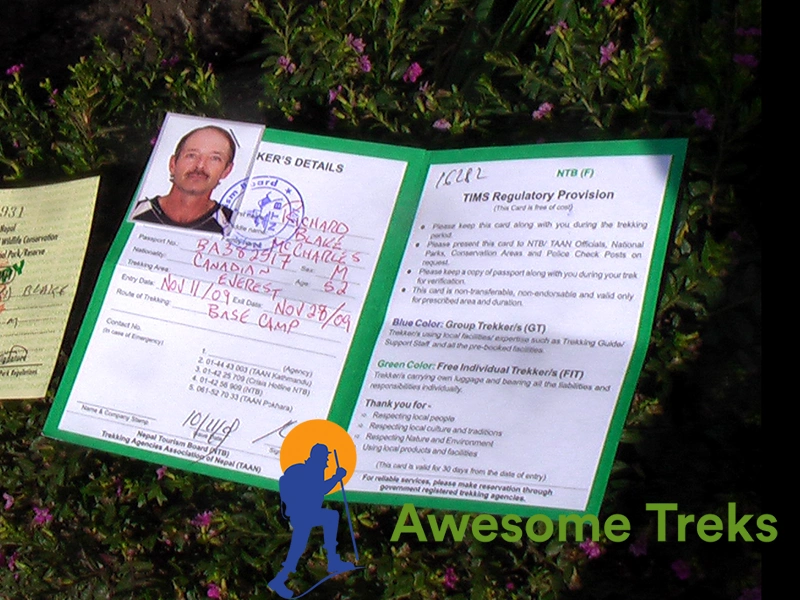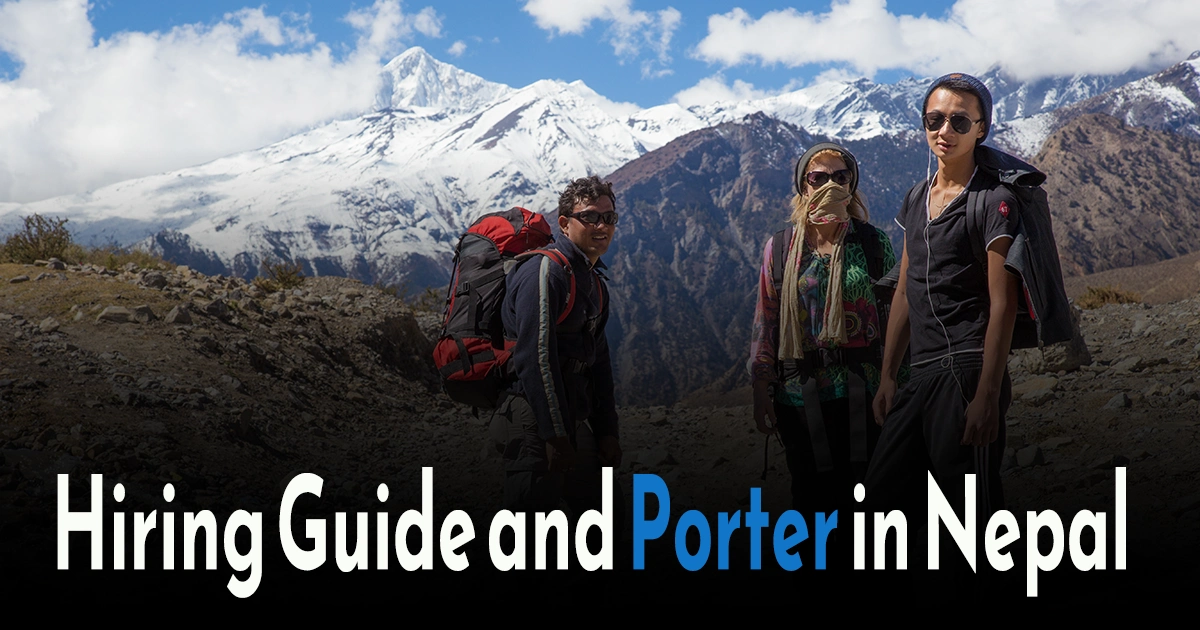Nepal’s towering Himalayas, vibrant villages, and serene trails promise an adventure like no other. But anyone who has trekked here knows that the journey isn’t just about the scenery – it’s about navigating challenging trails safely, connecting with local culture, and enjoying every step of the way. That’s where a trekking guide or porter comes in. Knowing how to hire the right support can transform your trek from a stressful ordeal into an unforgettable experience.
A licensed trekking guide does much more than point out breathtaking views. They are your safety net, navigator, cultural storyteller, and problem-solver rolled into one. On the other hand, a porter ensures your backpack isn’t weighing you down, letting you focus on the trek itself while supporting local livelihoods. Each plays a crucial role, but understanding their responsibilities, costs, and benefits is key to planning a smooth adventure.
With Nepal’s 2025 regulations requiring guides on major trekking routes like Everest, Annapurna, and Langtang, hiring professionals isn’t just smart – it’s the law. Beyond compliance, it’s a way to ensure safety, support the local economy, and make the most of your Himalayan journey.
In this guide, we’ll walk you through everything you need to know about hiring guides and porters; from legal requirements and costs to practical tips, ethical considerations, and insider advice. By the end, you’ll have the confidence to pick the perfect support and embark on a safe, thrilling, and unforgettable trekking journey in Nepal.
Understanding the Roles of Guides and Porters
When trekking in Nepal, knowing the difference between a guide and a porter is essential. Both provide valuable support, but their roles, responsibilities, and impact on your trek are distinct. Understanding these differences helps you make informed decisions, ensuring a safe, enjoyable, and culturally enriching experience.
Trekking Guide
A licensed trekking guide is more than a companion on the trail – they are your navigator, safety expert, and cultural interpreter.
Key responsibilities include:
- Navigation and Trail Knowledge: Guides know the routes, shortcuts, and hidden gems, helping you avoid getting lost or taking dangerous paths.
- Safety and First Aid: Guides are trained to handle emergencies, altitude sickness, injuries, and unexpected weather conditions.
- Cultural Insight: They provide local history, introduce you to traditions, and enhance your understanding of Nepalese communities.
- Logistical Support: Guides often handle permits, TIMS cards, accommodation, and meal arrangements, reducing stress for trekkers.
Porter

A porter primarily helps by carrying your luggage, allowing you to trek with a lighter load and more energy for the journey itself. Key aspects of hiring a porter include:
- Carrying Gear: Porters transport your backpacks, tents, or other heavy equipment. They do not handle navigation or emergencies.
- Physical Demands: Trekking with a porter ensures comfort but requires awareness of their weight limits and rest needs.
- Cost-Effectiveness: Hiring a porter is generally more affordable than a guide but does not replace a guide’s expertise.
Why Both Matter
Many trekkers choose a guide and porter combination, especially on challenging routes like Everest Base Camp or the Annapurna Circuit. While guides ensure safety, navigation, and cultural immersion, porters lighten your physical load, allowing you to enjoy the scenery and focus on the experience.
By understanding these roles, you can plan your trek wisely – ensuring safety, comfort, and a meaningful connection with Nepal’s landscapes and communities.
Legal and Regulatory Requirements for Hiring Guides and Porters
Trekking in Nepal isn’t just about adventure, it also involves complying with local laws and regulations designed to ensure safety, protect the environment, and support local communities. Understanding these requirements is crucial before hiring a guide or porter.
TIMS Card (Trekkers’ Information Management System)

All foreign trekkers in Nepal must obtain a TIMS card. This registration system allows authorities to track trekkers’ movements, monitor safety, and manage rescue operations if needed. Key points include:
- Can be obtained in Kathmandu or Pokhara through authorized trekking agencies.
- Required for trekking in most areas, including Annapurna, Langtang, and Everest regions.
- Must be carried at all times during the trek for verification.
Licensed Guide Requirement
As of 2023, Nepal mandates that all foreign trekkers hire a licensed guide on major trekking routes. This regulation applies to popular trails like Everest Base Camp, Annapurna Circuit, and Langtang Valley.
- Purpose: Enhance safety, reduce trekking accidents, and provide employment opportunities for local guides.
- Scope: Applies to both solo trekkers and small groups; guides must be licensed by the Nepal Tourism Board.
- Compliance: Trekking without a licensed guide on these routes may result in fines or denied access.
Regulations for Porters
While hiring a porter is not legally mandatory, there are guidelines to ensure their welfare:
- Agencies must provide fair wages, accommodation, and insurance.
- Porters should carry loads within recommended weight limits (generally 25-30 kg) to prevent health risks.
- Ethical treatment includes proper food, rest, and respect for local customs.
Importance of Compliance
Following these regulations ensures that your trek is:
- Safe: Guides are trained in first aid and emergency procedures.
- Legal: Avoid fines and complications on your trek.
- Ethical: Supports local communities and promotes sustainable tourism.
By understanding and following Nepal’s legal requirements for guides and porters, you can enjoy a smooth, safe, and rewarding trekking experience while respecting both the environment and local livelihoods.
Costs and Budget Considerations
Hiring a trekking guide or porter in Nepal is an investment in safety, comfort, and convenience. Understanding the typical costs, tipping practices, and budgeting tips helps ensure a smooth trek without unexpected financial surprises.
Guide Costs
- Daily Rate: Most licensed guides charge between $25-$40 per day, depending on the trek’s difficulty, season, and their experience.
- Inclusions: Rates generally cover the guide’s wages, accommodation, meals, and insurance. Some agencies also provide trekking gear if needed.
- Tipping: It is customary to tip guides 10-15% of the total cost at the end of the trek, based on service quality and trek duration.
Porter Costs
- Daily Rate: Porters typically charge $15-$25 per day, depending on the region and load carried.
- Inclusions: Rates usually cover wages, accommodation, meals, and insurance.
- Tipping: A tip of $5-$10 per day is standard, but adjust based on service and trek length.
Combined Guide and Porter Packages
Many trekkers hire both a guide and a porter, especially on challenging or long treks like Everest Base Camp or the Annapurna Circuit. Hiring both improves safety, logistics, and comfort, though the overall cost increases. Budget $40-$65 per day per person for combined services.
Budgeting Tips
- Book in Advance: Guides and porters booked through reputable agencies often have fixed rates, preventing surprises.
- Clarify Inclusions: Confirm if meals, accommodation, insurance, and transportation are included in the rate.
- Consider Seasonal Variations: Peak trekking seasons (spring and autumn) may have higher rates due to demand.
- Plan for Contingencies: Always carry extra cash for emergencies, additional services, or unexpected tips.
Cost vs. Value
While hiring a guide or porter adds to your budget, the value they provide in safety, cultural insight, and comfort far outweighs the cost. For first-time trekkers, remote routes, or challenging terrain, investing in experienced professionals ensures a memorable and worry-free trekking experience.
Where and How to Hire Guides and Porters
Hiring a trekking guide or porter in Nepal requires careful planning to ensure safety, professionalism, and ethical treatment. Choosing the right source can make your trek smoother and more enjoyable.
1. Trekking Agencies in Kathmandu and Pokhara
- Overview: Kathmandu and Pokhara are hubs for trekking agencies offering licensed guides and trained porters.
- Advantages: Booking in advance ensures verified credentials, availability, and insurance coverage. Agencies also provide guidance on permits, TIMS cards, and trekking logistics.
- Tips: Research agencies online, read reviews, and confirm their licenses and experience. Well-known agencies often offer package deals including guides, porters, and accommodations. For a trusted and reliable service, consider Awesome Holidays Nepal.
2. Hiring at Trailheads
- Examples: Lukla (for Everest), Jiri, or Syange (for Annapurna) offer on-site hiring options.
- Advantages: Convenient for last-minute trekkers or those already traveling independently.
- Disadvantages: Limited options, potentially higher rates, and less vetting. Quality and professionalism may vary.
- Tip: Only hire guides and porters with visible ID cards or licenses, and discuss your trekking plan and expectations before setting off.
3. Online Platforms
- Options: Several websites, including Nepal Independent Guide and reputable trekking agencies, allow booking guides and porters online.
- Advantages: Enables advance planning, verified credentials, and sometimes reviews or ratings from previous trekkers.
- Tips: Confirm the guide’s license, experience, and insurance coverage. Always use secure, trustworthy websites to avoid scams.
4. Tips for Hiring
- Verify Credentials: Ensure the guide holds a Nepal Tourism Board license and has prior trekking experience in your chosen region.
- Discuss Expectations: Clarify trekking pace, daily distances, accommodations, and any special needs.
- Confirm Costs and Inclusions: Know what is included in daily rates – meals, lodging, insurance, transportation, or tips.
- Respect Local Customs: Guides and porters are part of local communities; treat them ethically and support fair wages.
Why Proper Hiring Matters
Choosing the right guide or porter ensures safety, convenience, and cultural enrichment while supporting local employment and sustainable tourism. Proper hiring minimizes stress on the trek and maximizes enjoyment of Nepal’s trails.
Tips for Hiring Guides and Porters
Hiring a trekking guide or porter is more than just paying for services – it’s about ensuring safety, comfort, and a meaningful experience while trekking in Nepal. Here are some practical tips to help you make the right choice:
1. Verify Credentials and Experience
- Ensure your guide holds a Nepal Tourism Board license and has experience on your chosen trekking route.
- For porters, check physical fitness, previous trekking experience, and proper equipment.
- Agencies like Awesome Holidays Nepal provide verified, licensed guides and trained porters, giving trekkers peace of mind and reliable service.
2. Discuss Expectations Clearly
- Communicate your daily trekking pace, rest preferences, special needs, and desired cultural experiences.
- This ensures your guide can plan effectively, and your porter can manage loads accordingly.
3. Confirm Costs and Inclusions
- Ask for a detailed breakdown of daily rates, meals, accommodation, insurance, and tips.
- Clarify any additional costs, such as transportation to trailheads or extra services.
4. Prioritize Safety
- Guides should be trained in first aid, altitude sickness management, and emergency evacuation procedures.
- Porters should carry manageable loads, typically 25-30 kg, to avoid strain or injury.
5. Ethical Considerations
- Respect guides and porters as professionals – ensure fair wages, proper accommodation, and adequate rest.
- Supporting ethical trekking practices contributes to sustainable tourism and strengthens local communities.
6. Use Reputable Agencies
- Booking through trusted agencies like Awesome Holidays Nepal ensures licensed staff, clear contracts, and reliable support.
- Avoid hiring guides or porters informally at trailheads unless you can verify credentials and working conditions.
7. Maintain Open Communication
- A strong, respectful relationship with your guide and porter enhances your experience.
- Discuss concerns or adjustments during the trek to ensure safety, comfort, and mutual understanding.
By following these tips, you can hire guides and porters confidently, ensuring a safe, comfortable, and culturally enriching trekking experience in Nepal while supporting ethical tourism practices.
Practical Advice for Trekkers
Hiring a guide or porter in Nepal ensures safety and comfort, but your own preparation and behavior also play a crucial role in making the trek enjoyable for everyone involved. Here are some practical tips to help trekkers work effectively with guides and porters.
Pack Smart and Light
- Only bring essential gear. Your porter will carry your heavy load, but respecting weight limits (typically 25-30 kg) is essential to prevent injury.
- Distribute items like water, snacks, and small valuables in your personal backpack for easy access.
- Include trekking essentials such as layered clothing, sturdy boots, first-aid kit, and a portable charger.
Communicate Clearly
- Keep open communication with your guide about daily trekking pace, rest stops, and sightseeing preferences.
- Let your porter know about any special gear handling needs, such as fragile items.
- Clear communication minimizes misunderstandings and ensures smoother daily routines.
Respect Workload and Limits
- Porters carry heavy loads over challenging terrain – be mindful of rest breaks, hydration, and food needs.
- Never overload a porter beyond recommended limits; this keeps everyone safe and promotes ethical trekking practices.
Teamwork on the Trail
- Walk together as a team, respecting each other’s pace.
- Offer assistance if a porter or guide struggles with the terrain or heavy weather conditions.
- Positive interaction enhances camaraderie and makes the trek more enjoyable.
Observe Cultural Etiquette
- Guides and porters are often from local communities – show respect, greet them politely, and learn a few local phrases.
- Avoid behaviors that may offend local customs, and always follow guidance provided by your trekking staff.
Plan for Emergencies
- Know basic emergency procedures and carry a first-aid kit.
- Your guide will handle major emergencies, but being prepared ensures prompt response if needed.
Choose Reputable Agencies
- Agencies like Awesome Holidays Nepal ensure licensed guides and trained porters, fair working conditions, and proper insurance coverage.
By following these practical tips, trekkers can enhance safety, maintain ethical practices, and foster a positive trekking experience while fully enjoying the breathtaking landscapes and rich culture of Nepal.
Reflect & Explore
Hiring a trekking guide or porter in Nepal is more than a logistical choice – it’s an investment in safety, cultural connection, and meaningful travel. A licensed guide enriches your journey with local knowledge, ensures you stay safe on the trails, and navigates permits and logistics with ease. Meanwhile, porters take on the physical burden, allowing you to trek comfortably and focus on the breathtaking Himalayan landscapes.
While costs and arrangements may vary, the value of having reliable support is undeniable, especially in remote and high-altitude regions. By booking through reputable agencies, trekkers can be confident that they’re working with trained, insured, and fairly treated professionals, while also contributing to ethical and sustainable tourism.
As you plan your adventure for 2025 and beyond, remember that trekking in Nepal is not just about reaching a destination, it’s about the people who help you get there. With the right guide or porter by your side, you can experience the Himalayas with confidence, cultural depth, and peace of mind.
So take the step, hire wisely, and let Nepal’s mountains welcome you on a journey of a lifetime.
FAQ’s:
1. Do I need a guide for trekking in Nepal?
Not always. Some easy treks can be done independently, but for safety, cultural insight, and logistics, hiring a licensed guide is highly recommended.
2. Is it mandatory to hire a guide in Nepal?
Yes, for restricted regions like Upper Mustang, Manaslu, and Dolpo. For other treks, it’s optional but strongly advised.
3. How much does it cost to hire a trekking guide in Nepal?
Licensed guides usually charge $25-$40 per day, depending on trek length, difficulty, and season.
4. How much does it cost to hire a porter in Nepal?
Porters typically cost $15-$25 per day, including meals, accommodation, and insurance.
5. Do trekking guides in Nepal speak English?
Yes, most licensed guides speak English, and some may also know additional languages like French, German, or Chinese.
6. How do I know if a guide is licensed?
Licensed guides carry an official Nepal Tourism Board ID card with their name, license number, and photo.
7. Where can I hire a trekking guide or porter in Nepal?
You can book through agencies in Kathmandu or Pokhara, hire at trailheads, or use trusted online platforms.
8. What is the maximum load a porter can carry?
A porter typically carries 20-30 kg, depending on the trek and agency guidelines.
9. Should I tip my trekking guide and porter?
Yes, tipping is customary. Guides usually receive 10-15% of the trek cost, while porters are tipped around $5-$10 per day.
10. Are guides and porters insured in Nepal?
If hired through reputable agencies, guides and porters are covered by accident and medical insurance.
11. Can I hire a female trekking guide in Nepal?
Yes, agencies like Awesome Holidays Nepal provide trained female guides for trekkers who prefer them.
12. Do guides also arrange trekking permits?
Yes, licensed guides can arrange all necessary permits (TIMS, ACAP, Sagarmatha permits, etc.).
13. Can a porter also serve as a guide?
Some porters are training to become guides and may have basic English and route knowledge, but their main role is carrying loads.
14. Is it safe to hire guides and porters in Nepal?
Yes, if booked through licensed trekking agencies, it is very safe. Avoid informal hires without credentials.
15. What qualifications do trekking guides in Nepal have?
Guides undergo training in first aid, navigation, mountain safety, and high-altitude sickness management before being licensed.
16. How far in advance should I hire a guide or porter?
At least 2-4 weeks in advance during peak trekking seasons (spring and autumn) to secure availability.
17. Can guides help in emergencies?
Yes, licensed guides are trained to recognize altitude sickness, manage emergencies, and arrange evacuations.
18. Do porters and guides get proper meals and accommodation?
If hired ethically through agencies, their meals and accommodation are always included.
19. Can I change my guide or porter mid-trek?
Yes, through an agency, you can request a replacement if serious issues arise.
20. Why should I book with Awesome Holidays Nepal?
Because they provide licensed guides, trained porters, insurance coverage, and fair wages, ensuring a safe, ethical, and memorable trekking experience.
